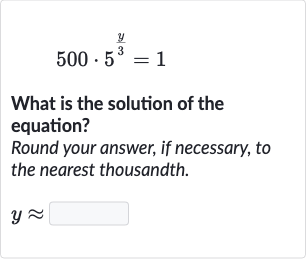Full solution
Q. What is the solution of the equation?Round your answer, if necessary, to the nearest thousandth.
- Write equation and solve for : Write down the equation and start solving for .We have the equation .
\newline y , we first need to isolate the term withy , which is5 5 3 3 \newline 500 500 \newline 5 5 3 3 1 1 500 500 - Isolate term with y: Apply the logarithm to both sides of the equation to solve for the exponent.
\newline \newline ln ( 5 ( y 3 ) ) = ln ( 1 500 ) \ln(5^{(\frac{y}{3})}) = \ln(\frac{1}{500}) - Apply logarithm to both sides: Use the power property of logarithms to bring down the exponent.
\newline ln ( a b ) = b ⋅ ln ( a ) \ln(a^b) = b \cdot \ln(a) \newline \newline ( y 3 ) ⋅ ln ( 5 ) = ln ( 1 500 ) \left(\frac{y}{3}\right) \cdot \ln(5) = \ln\left(\frac{1}{500}\right) - Use power property of logarithms: Solve for
y y \newline ln ( 5 ) \ln(5) ln ( 1 500 ) \ln(\frac{1}{500}) \newline 3 3 y y \newline y = 3 ⋅ ln ( 1 500 ) ln ( 5 ) y = \frac{3 \cdot \ln(\frac{1}{500})}{\ln(5)} - Solve for
y y \newline \newline ln ( 5 ) ≈ 1.60944 \ln(5) \approx 1.60944 \newline ln ( 1 / 500 ) ≈ − 6.21461 \ln(1/500) \approx -6.21461 \newline y y \newline y = 3 × ( − 6.21461 ) 1.60944 y = \frac{3 \times (-6.21461)}{1.60944} \newline y ≈ − 11.552 y \approx -11.552 - Perform calculations: Round the answer to the nearest thousandth.
\newline y ≈ − 11.552 y \approx -11.552 \newline \newline y ≈ − 11.552 y \approx -11.552
More problems from Solve exponential equations using common logarithms
QuestionGet tutor help
QuestionGet tutor help
QuestionGet tutor help
QuestionGet tutor help
QuestionGet tutor help
QuestionGet tutor help
QuestionGet tutor help
QuestionGet tutor help
QuestionGet tutor help

